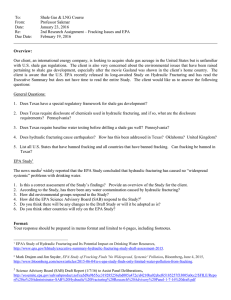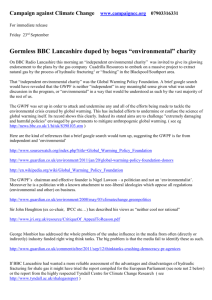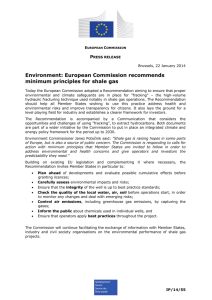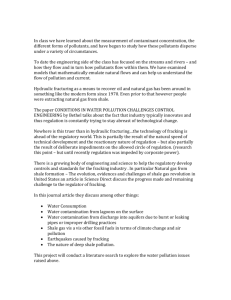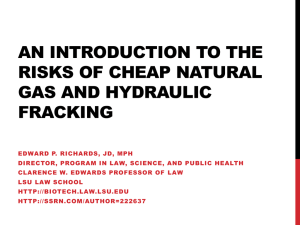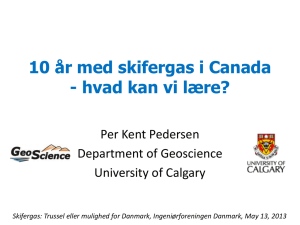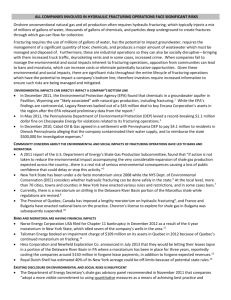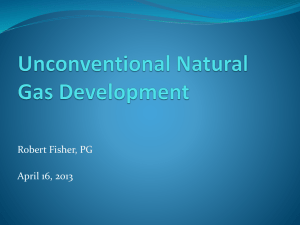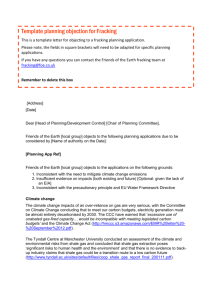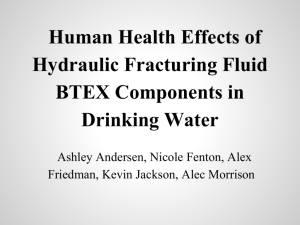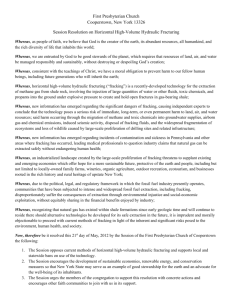Fracking Powerpoint Presentation (May 8, 2014)
advertisement
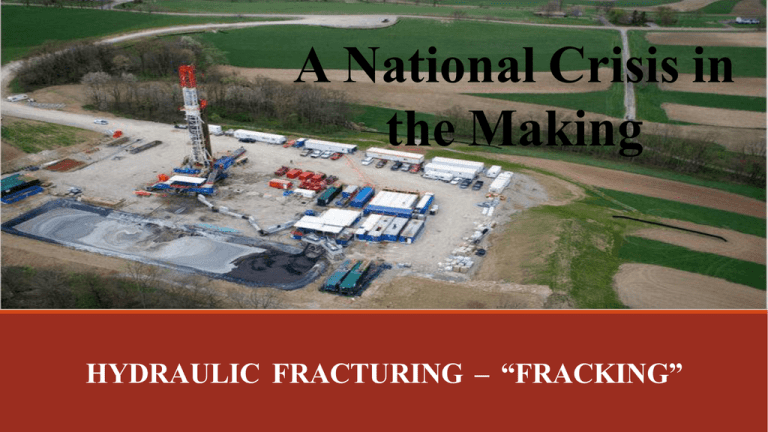
A National Crisis in the Making HYDRAULIC FRACTURING – “FRACKING” What is Fracking? Fracking is a form of gas and oil well drilling Drill 7,500 feet down Forcing water, sand, and chemicals into shale – (a form of sedimentary rock) Release oil and gas Shale Oil and Gas Reserves (U.S. Energy Information Administration – eia) National Issues from Natural Gas Production by Fracking PROS CONS Creates jobs nationally Water and air contamination Less CO2 emissions than using coal or oil Harmful to humans, livestock, and crops Tax revenue Excessive water usage Lease income from Public Lands use Energy independence from foreign oil ,create trade surplus from export of liquid natural gas (LNG) Geopolitical implications http://www.youtube.com/watch?v=7uVGY3sIBsA Seismic activity Costs for regulation, inspection, litigation, cleanup Cumulative effects of fracking is still unknown Generally unregulated Still produces CO2 at significant levels NOT A RENEWABLE ENERGY SOURCE The Expert Opinions on Fracking BLM - (U.S. Department of the Interior, Bureau of Land Management) “Companies pay for development of public energy resources. Total royalty, rentals, and bonus payments vary from year to year. In fiscal year 2008, $5.5 billion was paid to Federal and State governments for Federal onshore energy leasing and production. For oil and gas, half of this money goes to the States and half goes to the U.S. Treasury.” http://www.blm.gov/wo/st/en/prog/energy.html USGS - (United States Geological Survey) “USGS has conducted research that associates deepwell fluid injection, a process sometimes used to dispose of produced waters or flowback waters from hydraulic fracturing and gas production, with the triggering of earthquakes.” “Concerns also exist regarding the potential contamination of fresh groundwater resources from oil and gas extraction wells that use hydraulic fracturing; either from the petroleum resource being produced or from the chemicals introduced in the fracturing process. USGS is studying well water quality in several states where hydraulic fracturing is being practiced, including Arkansas, New York, Pennsylvania, and Wyoming. “ http://www.usgs.gov/hydraulic_fracturing/ GAO – (U.S. Government Accountability Office) Water is also the primary component of fracturing fluid. Table 3 shows the average amount of freshwater used to drill and fracture a shale oil or gas well. Average freshwater used (in gallons): Shale play For drilling For hydraulic fracturing Barnett 250,000 4,600,000 Eagle Ford 125,000 5,000,000 Haynesville 600,000 5,000,000 Marcellus 85,000 5,600,000 Niobrara 300,000 3,000,000 Table 3: Average Freshwater Use per Well for Drilling and Hydraulic Fracturing Source: GAO analysis of data reported by George King, Apache Corporation (2011). GAO – (U.S. Government Accountability Office) “Oil and gas development, whether conventional or shale oil and gas, pose inherent environmental and public health risks, but the extent of these risks associated with shale oil and gas development is unknown, in part, because the studies GAO reviewed do not generally take into account the potential long-term, cumulative effects.”(Summary) http://gao.gov/products/GAO-12-732 OSHA – (Occupational Safety & Health Administration) “Hydraulic fracturing sand contains up to 99% silica. Breathing silica can cause silicosis. Silicosis is a lung disease where lung tissue around trapped silica particles reacts, causing inflammation and scarring and reducing the lungs' ability to take in oxygen.ii Workers who breathe silica day after day are at greater risk of developing silicosis. Silica can also cause lung cancer and has been linked to other diseases, such as tuberculosis, chronic obstructive pulmonary disease, and kidney and autoimmune disease.” https://www.osha.gov/dts/hazardalerts/hydraulic_frac_hazard_alert.html U.S. Department of Energy “Protection of water quality through a systems approach. At present neither EPA or the states are engaged in developing a systems/lifecycle approach to water management.” “Agencies should review field experience and modernize rules and enforcement practices to ensure protection of drinking and surface waters. Reflects Subcommittee unease that the present arrangement of shared federal and state responsibility for cradle-tograve water quality is not working smoothly or as well as it should.” “Managing short-term and cumulative impacts on communities, land use, wildlife, and ecologies. No new studies launched; funding required from federal agencies or from states.”(p.8) http://www.shalegas.energy.gov/resources/111811_final_report.p df U.S. Department of Energy “The Subcommittee believes that if action is not taken to reduce the environmental impact accompanying the very considerable expansion of shale gas production expected across the country – perhaps as many as 100,000 wells over the next several decades – there is a real risk of serious environmental consequences causing a loss of public confidence that could delay or stop this activity. The Subcommittee cautions that whether its approach is followed or not, some concerted and sustained action is needed to avoid excessive environmental impacts of shale gas production and the consequent risk of public opposition to its continuation and expansion.” (Shale Gas Production Subcommittee Second Ninety Day Report November 18, 2011, p.10) http://www.shalegas.energy.gov/resources/111811_final_report.p df EPA – (Environmental Protection Agency) “Overall, EPA found that applying wastewater discharge requirements would impose significant burdens in terms of immediate or early shutdown and loss of gas production from the projects that remained economically viable at 2008 and 2010. For new projects, EPA reached the following findings: (1) CBM projects do not generally appear economically viable at present, and for many development opportunities, for substantial periods into the future, and (2) discharge requirements would further delay these projects‟ economic viability. Given these findings for both existing and new sources, EPA‟s judgment at this time is that it should not move forward with additional regulation of wastewater discharges from CBM projects. Pending changes in CBM gas production economics, and increased volume of CBM activity and wastewater discharges, and possible changes in the available wastewater management approaches and/or associated costs, EPA may revisit this decision in future years.” http://water.epa.gov/scitech/wastetech/guide/oilandgas/upload/cbme a2013.pdf There are benefits to increased production of natural gas from fracking Conclusions However, every government agency that has investigated fracking concurs that fracking poses many difficult, and possibly unknown, complications to the environment and to humans Continued dependence on natural gas development will delay development of renewal energy sources Current infrastructure can not easily convert from coal and oil based sources to natural gas Dangers are still undetermined WEBSITE: http://perspectivesonfracking.wordpress.com/
